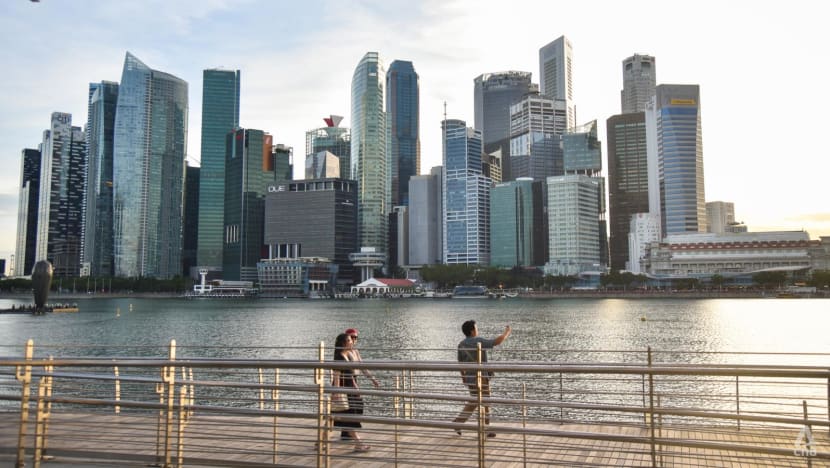Singapore keeps 2023 GDP forecast at 0.5-2.5%, expects growth to be 'around the mid-point' of this range
Singapore’s external demand outlook for the rest of the year has weakened, said the Ministry of Trade and Industry in its quarterly report.

The Singapore skyline. (File photo: CNA/Syamil Sapari)
SINGAPORE: Singapore has maintained its growth forecast for 2023 at 0.5 per cent to 2.5 per cent, with growth likely to “come in at around the mid-point” of this range, the Ministry of Trade and Industry (MTI) said on Thursday (May 25).
The decision comes alongside data showing the economy growing by 0.4 per cent year-on-year between January and March.
This is higher than the advance estimates of 0.1 per cent, but still marks a sharp slowdown from the 2.1 per cent growth in the previous quarter.
Growth in the first three months of the year was weighed down by contractions in the manufacturing, wholesale trade and finance and insurance sectors amid weakness in the global economy and the electronics downcycle, said MTI’s permanent secretary for policy Gabriel Lim.
On a quarter-on-quarter seasonally adjusted basis, the economy shrank by 0.4 per cent in the first quarter, a reversal from the 0.1 per cent growth in the previous quarter.
MTI does not expect Singapore to enter a technical recession, said the ministry's chief economist Yong Yik Wei. A technical recession is defined by economists as two consecutive quarter-on-quarter contractions.
While the first half of the year could see “fairly flattish or very low” growth numbers, the economy is set to pick up gradually later in the year with support from the services sector, said Ms Yong.
“Given the downside risks and the weakening outlook, we cannot rule out the possibility that there could be some quarters of negative quarter-on-quarter growth this year but again, that’s not our baseline,” she told reporters at a press conference.
Singapore has maintained its growth forecast for 2023 at 0.5 per cent to 2.5 per cent, with growth likely to “come in at around the mid-point” of this range, the Ministry of Trade and Industry said on Thursday (May 25). Heidi Ng with more.
WEAKER EXTERNAL DEMAND OUTLOOK
In its assessment of the economic outlook ahead, MTI said the performance of advanced economies, such as the United States and Eurozone, has turned out to be more resilient than expected since its last quarterly update in February.
Nonetheless, their outlook for the rest of the year remains weak, with growth in the US and Eurozone set to decelerate more significantly in the second half of the year due to the lagged effects of monetary policy tightening.
On the other hand, China’s economic recovery is likely to be stronger than earlier expected, driven by a pickup in domestic services consumption following the lifting of its COVID-19 restrictions.
But continued stresses in the country’s property market, as well as weakness in the industrial sector amid subdued external demand conditions, will continue to weigh on the recovery.
With that, MTI noted that Singapore’s external demand outlook for the rest of the year has weakened.
“Apart from the expected slowdown in the advanced economies, the electronics downcycle is likely to be deeper and more prolonged than earlier projected,” it said in its report.
“Spillovers from China’s services-led recovery are also expected to remain weak given that services activities are less import-intensive than industrial activities.”
At the same time, downside risks in the global economy have risen.
These include recent banking sector stresses that have increased the risk of a sharper-than-expected tightening in global financial conditions, as well as escalations in the Ukraine war and geopolitical tensions among major global powers.
Turning to the domestic outlook, MTI said prospects of the local aviation- and tourism-related sectors remain positive given the ongoing recovery in international air travel and inbound tourism.
However, the outlook for the manufacturing and other trade-related sectors has weakened.
In particular, the manufacturing sector is projected to see a deeper downturn, led by output contractions in the electronics and precision engineering clusters in tandem with weaker global semiconductor demand, as well as the chemicals cluster due to sluggish demand from China.
Growth in the water transport and finance and insurance sectors is also likely to be dampened by the broader slowdown in the global economy.
Asked for an assessment of the labour market, Mr Kenny Tan, divisional director for manpower planning and policy at the Ministry of Manpower (MOM), noted that job figures tend to lag changes in the economy “usually by at least two quarters”.
The labour market also remains tight with low unemployment, although there could be “some unevenness” moving forward, he said in response to a query from CNA.
Advance estimates released by MOM last month showed that the labour market continued to expand in the first quarter of 2023, although at a more moderate pace than the previous quarter.
Unemployment rates remained low amid robust hiring demand, but retrenchments rose for the third consecutive quarter to 4,000 in the first three months of the year.
While the retrenchment numbers matched levels last seen in 2016 and 2017, they remain “very low”, said Mr Tan.
Statistics on re-entry into employment also remain high, indicating that “roughly 60 to 70 per cent” of retrenched workers have been able to secure a new job within six months, he added.
Also speaking at the press conference, Mr Edward Robinson, deputy managing director of the Monetary Authority of Singapore (MAS), said the central bank’s current monetary policy stance remains appropriate.
The MAS left its monetary policy unchanged last month, hitting the pause button on a series of tightening moves it began since October 2021 to combat rising inflation.
It said it will “maintain the prevailing rate of appreciation” of its Singapore dollar nominal effective exchange rate policy band, with no changes to the width and the mid-point of the band.
Mr Robinson said the MAS continues to “watch developments closely on both the growth and inflation fronts” and will assess its policy settings again at its next scheduled policy review in October.
Separately, policymakers have cut Singapore’s growth forecasts for non-oil domestic exports (NODX) and total merchandise trade this year. This comes after a "worse-than-expected" performance in the first quarter of the year.
Singapore now expects NODX to shrink by 8 per cent to 10 per cent, and total merchandise trade to decline by 6 per cent to 8 per cent, on the back of the manufacturing downcycle and lower oil prices.


















